Disclosure: Meeple Mountain received a free copy of this product in exchange for an honest, unbiased review. This review is not intended to be an endorsement.
I like the various flavors of “and write” games. I have had a lot of fun with games like Welcome To… (flip and write), and most recently Ganz schön clever (roll and write). Some are theme-less number puzzles (not that there’s anything wrong with that), while others can stretch the limits and do something quite spectacular. I have liked seeking out ancient ruins with Lost Cities Roll and Write, for example. Although I have had a great deal of fun playing Floorplan, it is the fact that the houses that you design in that game, thanks to the dice-driven choices, are not functional. Most of the time, they are not even close. It has been experiences like that which colored my initial expectations for Fantasy Map Maker, a roll and write from Doopy Games. I was pleasantly surprised.
Back in the day, I played a lot of Traveller. That game had systems for randomly generating just about everything! From characters (with their backgrounds) to sectors of space (including the stars, the planets, and the societies that lived on them). Each of these systems was a mini game—you could spend hours having a blast generating characters or interconnected planetary systems. As I played Fantasy Map Maker, it reminded me of my days of generating those sectors of space. The only differences being the genre of the map (fantasy vs. sci-fi) and the fact that the fantasy maps tended to make more sense than those random sectors of space did. 😏
Gameplay Overview
To play Fantasy Map Maker, you need five quest cards, a player sheet, two standard dice, and a pencil (with a good eraser).
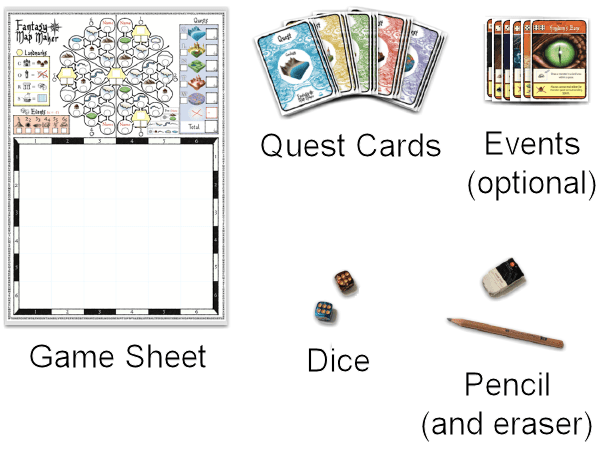
The quest cards are what determine how the game is going to be scored. There are fifteen of them; three each in five different categories (geology, landmarks, nature, towns, and the wheel). Each card has a goal and a point value. The point value is earned for each example of the goal in your final map.
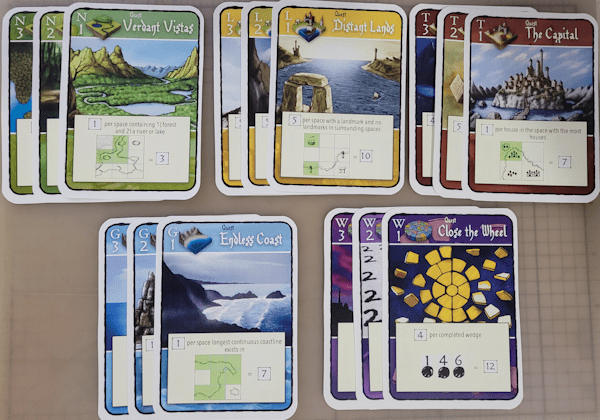
The player sheet has an area for you to draw your map (a 6×6 grid of squares), the feature wheel, a scoring area, and some player aids. All in all, it is quite the efficient use of space. After you skim the rules, pretty much everything on that sheet makes perfect sense.
To start the game, you need to roll the dice twice, each time selecting one of the dice to be written into the two boxes in the center hexagonal space of the feature wheel. Once you have the two numbers, you will place your first landmark. The rules recommend that you start with a castle, although any of the other landmarks (i.e., outpost, ruins, or ship) work just as well.
The first landmark grants you ‘explored’ status on one of the 36 spaces on your map. This is important because each time you draw a new feature on your map, it needs to start in a segment you have explored. Each type of feature has special rules for how it can go from there.
- Small features (houses, streams, lakes, and islands) must be drawn entirely within a space that is already explored.
- Large features (mountains, and forests) and long features (rivers, roads, and coastline) must start in an explored space, but can expand into neighboring spaces. These new spaces are considered explored for future turns.
- Landmarks (castles, outposts, ruins, and ships) must be drawn entirely within a space, however that space is dictated by die rolls and does not need to have been explored prior.
- Names are a special case. They do not represent features, per se, they are the labels on a map giving other features an identity. These have no placement restrictions, but do not cause the spaces they are in to become explored. If you are not good at coming up with names for things, the player sheet has a very handy border that includes many, many map and feature name snippets to help inspire you.
As indicated above, each type of feature has multiple features within it. Each of those specific features comes with its own restrictions and rules. And, of course, depending upon the quest cards, will score differently.
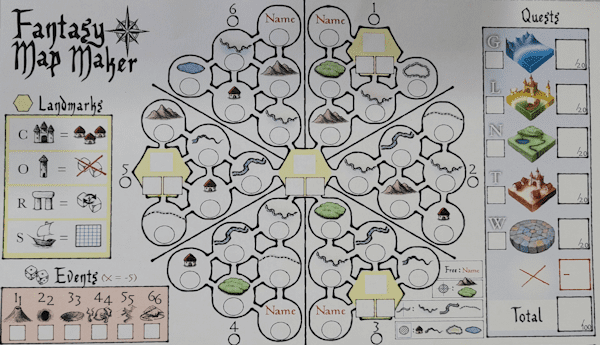
The way you add these features to your map is via the feature wheel. At the start of each turn, one player will roll the dice. Each player will select one of those dice to be the wedge of the wheel from which they will be selecting one of six possible features. The feature chosen each turn must be adjacent to a feature that has already been used. Thus, at the start of the game, after the placement of the initial landmark, there are six possible choices… that will be reduced to two once the dice are rolled.
Once a feature is selected, the second die (the one not used to select the wedge) has its value written in the circle under the selected feature’s image. This is how many of those features need to be drawn. For example, if the dice were to come up 2, 4 on that second turn, and you chose to go into wedge 2, you would write a 4 in the circle under the coastline image, meaning you would be drawing 4 coastline segments.
If the last feature in a wedge is selected, the player marks the circle under the wedge number to remind them that dice of that value can no longer be used for that wedge.
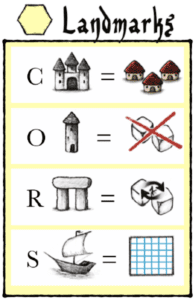
If a player selects a landmark feature (any of the hexagonal feature spaces), they will roll the dice a second time to get the second number of the map grid coordinate where the feature will go. They select one of the four landmarks and write the initial of that landmark (i.e., C, O, R, or S) in the hexagonal feature space, then draw the feature on the map in a space that corresponds to the coordinates selected. Each landmark has a special characteristic.
- Castles count as three houses when scoring Towns quests. Additional castles continue to add three houses to a space when drawn.
- Outposts allow you a one-time ability to ignore the dice and assign the numbers you want. Additional outposts offer the same one-time ability.
- Ruins allow you a one-time ability to adjust the dice by assigning them any combination that would come up to the same sum as what was rolled. For example, if you rolled a 1 and 6, the sum is 7, so the dice could be reassigned to 2 and 5, or to 3 and 4. Additional ruins offer the same one-time ability.
- Ships allow you to, for the rest of the game, draw features in any space of the map, not just explored spaces. Additional ships do nothing.
A player’s game ends when the dice are rolled and they cannot use them to select a feature. This usually means that the dice each has a value of a wedge segment that has been completed and the player has no way to alter the die results (i.e., an outpost or ruins). Once all player’s games have ended, the scores are tallied up per the quest cards, and the high score wins.
Event Cards
Once you have a few plays of the basic game under your belt, you might want to add in Events. Events are implemented here in a way that I think my colleague Justin Bell would approve of. There are six event cards. Players may choose to exclude them or add in any number of them.
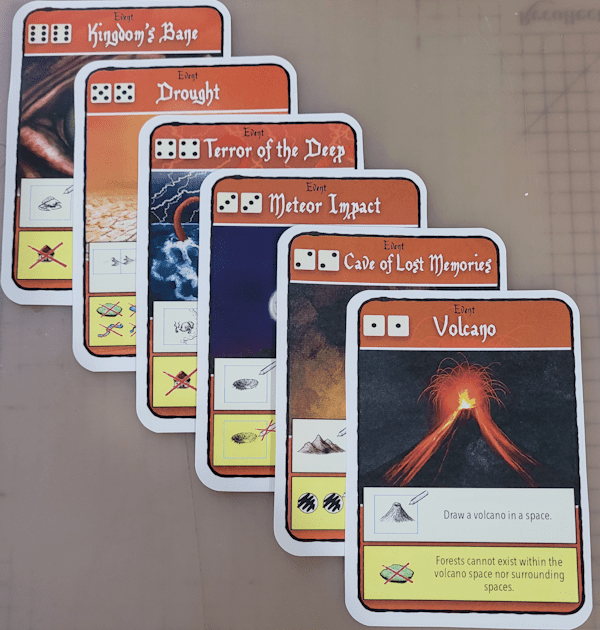
Each event has a doubles-pair value assigned to it (i.e., 11, 22, 33, 44, 55, and 66). When doubles are rolled, if the corresponding event is in play and has not yet been triggered in this game (each event can only be triggered once), the event is resolved. Each event will cause the players to draw in a feature and may have ongoing effects.
The Volcano event (above), for example, tells the players to draw a volcano somewhere on their map. The restriction is that it cannot be placed in a space where there are forests in that space or in the surrounding spaces; this restriction also means that forests cannot be added to any of those spaces for the rest of the game.
Thoughts
As I said above: I was pleasantly surprised. Fantasy Map Maker does not result in the sorts of insanity that Floorplan does (or the inexplicability of Traveller sector maps). What you have at the end of the game is a surprisingly interesting and semi-realistic depiction. Features often extend off the edges of the map suggesting that this is just one small part of a much larger whole.
In fact, this is the sort of game that could be used as a tool to help create maps for use in fantasy role playing games. Sure, the Game Master might want to embellish a bit or put a few of these regions together, but I think this is well in keeping with the spirit of the game.
If I have a complaint it is this: the game end trigger can come along rather suddenly and end a player’s game while others continue on. This “continue on” period can be rather lengthy. In my first game, my wife and I were having a good time when double-5s were rolled. I had completed the 5-wedge of my wheel and had no way to change the numbers… so I was done. My wife played out another 11 turns after. I enjoyed watching her map progress, so it was not a huge deal, but I felt truncated.
Here is the map I made in that first game. I am no artist by any means, but I liked how it turned out. I just wish I had more time. I had plans for that road!
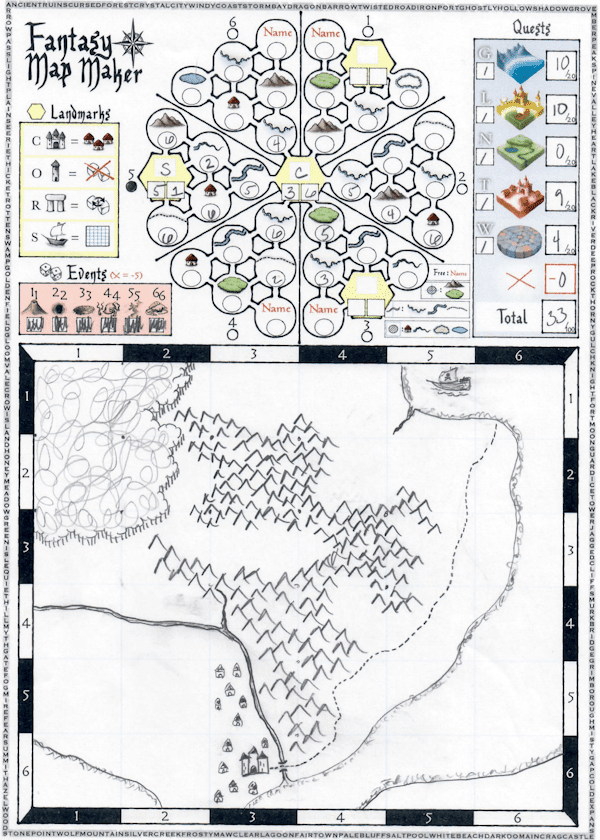


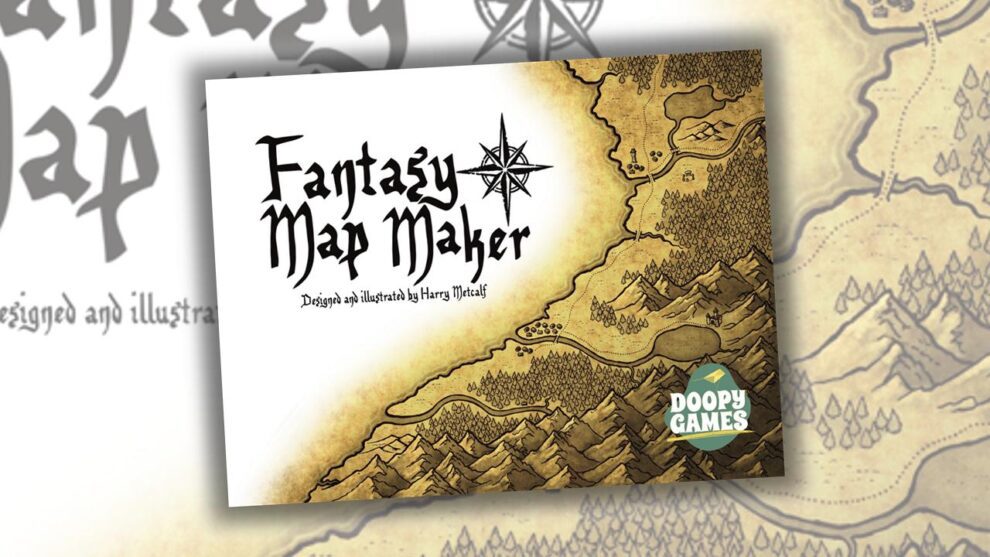

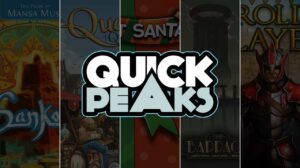
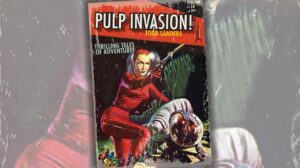
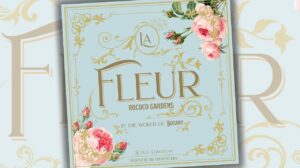




Your review of Fantasy Map Maker piqued my interest in a good way. I’ve always loved maps of any kind and loved studying them, whether they’re made by cartographers, hobbyists, or children. Dungeon and fantasy settings are my favorite. This game sounds like it’s exactly what I’d enjoy the most (especially solo). But I do agree with you that a players participation ending early while the others continue the fun is a bit offsetting. Hopefully, a future edition will have solved that big problem.
Many thanks for your great review. It is detailed enough such that I had a very good idea of how the game works.
GaryN — I am so glad you liked the review! It is a very cool game. I have found that playing solo and just ignoring a turn when I would be caused to stop works well for me… I stop when the map seems to be done. 🙂